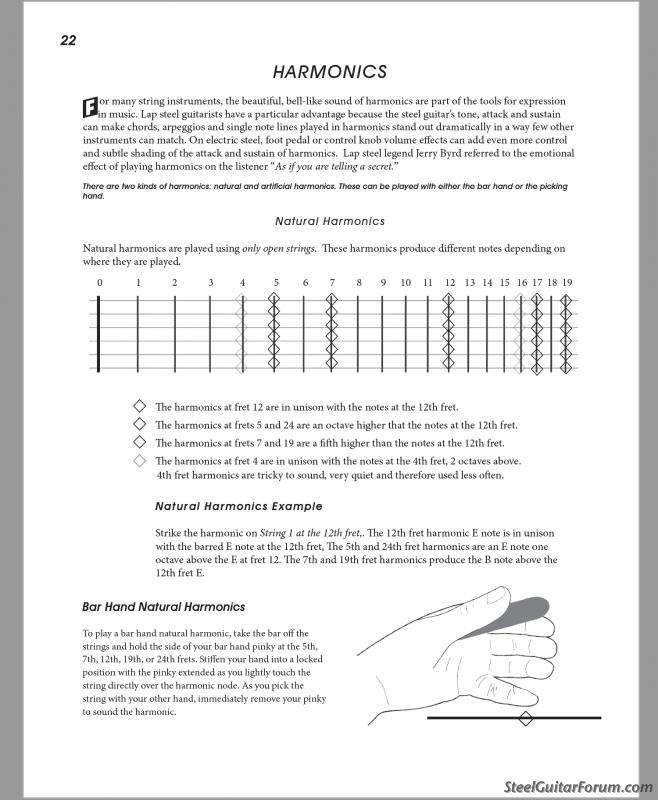| Author |
Topic: *Other* harmonics |
Levi Gemmell
From:
New Zealand
|
 Posted 4 May 2017 8:15 pm
Posted 4 May 2017 8:15 pm |
|
Something has me puzzled, and as I don't have a highly-developed ear, I am really not sure what's going on.
I have watched Ronald Kanahele and Timi Abrigo in various YouTube videos, and obviously they use the distinctive "Avon-bell" chimes -- something we, naturally, hear Benjamin and Feet Rogers doing too -- but they also do something which I don't understand.
If one places the bar and produces a harmonic by palm-placement twelve frets above (i.e. the actual desired note), what happens when you pick closer to the bar? It seems to me that you can pick different harmonics in different places without moving the bar along the same string. I have tried this myself and am impressed by the results but I do NOT get it.
How do I know what these notes are? How/why are those different notes being made/ What's going on? 
_________________
Commodore S-8
John Allison S-8
JB Frypan S-8
Sho~Bud LDG SD-10
1966 Fender Super Reverb |
|
|
 |
David M Brown
From:
California, USA
|
 Posted 5 May 2017 5:40 am
Posted 5 May 2017 5:40 am |
|
Natural harmonics are found at several places along the string length - the octave at the halfway point, the 12th at the 2/3 point, etc.
Artificial palm or knuckle harmonics work the same way, except that the bar now determines the string length.
So halfway between the bar and the bridge still is the octave, 2/3 is still the 12th, 1/4 of the distance is the double octave. etc. |
|
|
 |
Andy Volk
From:
Boston, MA
|
 Posted 5 May 2017 6:11 am
Posted 5 May 2017 6:11 am |
|
You can play open string harmonics at several frets ... The 12th, 5th and 7th frets are the strongest. On an electric steel you can sometimes also use the 4th fret as well but it's not as reliable.
When you move the bar up the neck covering all strings you are essentially creating a moveable nut. So, if you have a straight bar at fret #2, your 5th fret harmonics move to fret 7, your 7th fret harmonics are now at fret 9, and your open string harmonics at fret 12 have moved to fret 14. Using artificial harmonics, you can play 12 frets, 5 frets or 7 frets above the bar. The Hawaiian song "Whispering Lullaby" uses these closer-to-the bar harmonics.

_________________
Steel Guitar Books! Website: www.volkmediabooks.com |
|
|
 |
Jim Newberry
From:
Seattle, Upper Left America
|
 Posted 5 May 2017 10:14 am
Posted 5 May 2017 10:14 am |
|
You haven't lived until you've watched Bobby Ingano run through his chimes when he warms up. I just experienced that last week! Jeepers.
_________________
"The Masher of Touch and Tone"
-1950 Fender Dual Pro 8
-1950's Fender Dual Pro 6
-Clinesmith D8
-Clinesmith 8-string Frypan
-Clinesmith Joaquin
-~1940 National New Yorker
-~1936 Rickenbacher B6
-Homebuilt Amps |
|
|
 |
Andy Volk
From:
Boston, MA
|
|
|
 |
Levi Gemmell
From:
New Zealand
|
 Posted 5 May 2017 1:03 pm
Posted 5 May 2017 1:03 pm |
|
| David M Brown wrote: |
| So halfway between the bar and the bridge still is the octave, 2/3 is still the 12th, 1/4 of the distance is the double octave. etc. |
| Andy Volk wrote: |
| So, if you have a straight bar at fret #2, your 5th fret harmonics move to fret 7, your 7th fret harmonics are now at fret 9, and your open string harmonics at fret 12 have moved to fret 14. Using artificial harmonics, you can play 12 frets, 5 frets or 7 frets above the bar. |
Thank you so much for the clarification. I understand now what was happening.  I look forward to finding ways to use them... Beautiful playing by Alan Akaka there too, what a lovely song. I look forward to finding ways to use them... Beautiful playing by Alan Akaka there too, what a lovely song.
Does anyone have other visual examples of harmonics being played this way?
_________________
Commodore S-8
John Allison S-8
JB Frypan S-8
Sho~Bud LDG SD-10
1966 Fender Super Reverb |
|
|
 |




